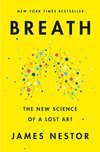
Saved by Daniel Wentsch and
Breath: The New Science of a Lost Art

Saved by Daniel Wentsch and
“An early soft diet prevents the development of the muscle fibers of the tongue,” he wrote more than a century ago, “resulting in a weaker tongue which [cannot] drive the primary dentition out into a spaced relationship with fully developed arches which will lead to more crowding of the permanent teeth.”
it’s no coincidence that eight of the top ten most common cancers affect organs cut off from normal blood flow during extended states of stress.
The key to optimum breathing, and all the health, endurance, and longevity benefits that come with it, is to practice fewer inhales and exhales in a smaller volume. To breathe, but to breathe less.
panic, like asthma, is usually preceded by an increase in breathing volume and rate and a decrease in carbon dioxide. To stop the attack before it struck, subjects breathed slower and less, increasing their carbon dioxide. This simple and free technique reversed dizziness, shortness of breath, and feelings of suffocation. It could effectively cure
... See moreBut if it’s true, it could explain why so many drugs don’t work for panic, anxiety, and other fear-based conditions, and how slow and steady breathing therapy does.
What if overbreathing wasn’t the result of hypertension and headaches but the cause? Buteyko wondered. Heart disease, ulcers, and chronic inflammation were all linked to disturbances in circulation, blood pH, and metabolism. How we breathe affects all those functions. Breathing just 20 percent, or even 10 percent more than the body’s needs could ov
... See moreHumans “rust” as well. As the cells in our bodies lose the ability to attract oxygen, Szent-Györgyi wrote, electrons within them will slow and stop freely interchanging with other cells, resulting in unregulated and abnormal growth. Tissues will begin “rusting” in much the same way as other materials. But we don’t call this “tissue rust.” We call i
... See moreThe missing pillar in health is breath. It all starts there.
Chemoreception is one of the most fundamental functions of life. When the first aerobic life forms evolved two and a half billion years ago, they had to sense carbon dioxide to avoid it. The chemoreception that developed passed up through bacteria to more complex life. It’s what stimulates the suffocating feeling you just felt holding your breath.